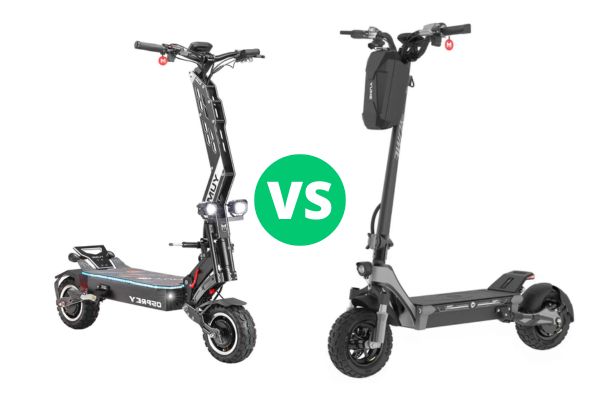Electric scooters are becoming more popular as people look for affordable, fast, and fun ways to move around. Yume, a Chinese scooter brand, has caught the attention of many with its powerful specs and low prices. However, it also has a reputation for mixed build quality and limited customer support. This puts buyers in a tough spot, the “Yume Dilemma.” You get a lot for your money, but you may have to fix or adjust things yourself.
This article compares two very different Yume scooters: the Osprey and the Swift. They are not direct competitors, but they show two sides of Yume’s design approach. The Yume Osprey is a high-speed, heavy-duty scooter built for thrill seekers. The Yume Swift is a lighter, commuter-focused scooter designed for city travel with some excitement. In this guide, we’ll look at every important detail, specs, ride experience, performance, and ownership, to help you decide which one is right for you.
Yume Osprey vs Swift: A Comprehensive Specification Showdown
Let’s begin by comparing the technical details of both scooters. Keep in mind, some numbers vary depending on where you look. We’ve listed the most reliable ones.
| Feature | Yume Osprey | Yume Swift | Notes |
| Price (USD) | $2,299 (Standard), $2,849 (Samsung) | ~$949 | Swift price varies by seller |
| Motor (Nominal) | Dual 3500W (7000W total) | Single 1200W | Major difference in power setup |
| Motor (Peak) | ~10,080W | ~1528W | Peak numbers reflect controller output |
| Voltage | 72V | 48V | Big difference in power capacity |
| Battery (Ah) | 36Ah or 40Ah (Samsung) | 22.5Ah | Osprey offers premium Samsung cells |
| Battery (Wh) | ~2592Wh / ~2880Wh | ~1080Wh | Osprey has much larger energy storage |
| Top Speed (Claimed) | 60 MPH | 32 MPH | Swift may reach up to 35 MPH in testing |
| Max Range (Claimed) | 75–100 miles | 37 miles | Range depends heavily on speed and weight |
| Brakes | Dual 160mm Hydraulic | Dual 140mm Hydraulic | Swift brakes have cooling fins |
| Suspension | Adjustable Hydraulic (F&R) | Spring (Front), Hydraulic (Rear) | Osprey has a higher-end suspension |
| Tires | 11” Off-Road Tubeless | 10” All-Terrain Tubeless | Both use puncture-resistant tires |
| Weight | 123 lbs (56 kg) | ~58–60 lbs | Swift weight may vary across sources |
| Max Load | 330 lbs | 280 lbs | Osprey supports heavier riders |
| Controllers | 2x 18-mosfet 57A Sine Wave | 1x 9-mosfet 27A Sine Wave | Both use a sine wave for smoother power |
| Display | Full Color LCD | Full Color LCD | Easy to read in sunlight |
| Throttle | Thumb & Trigger (Both Included) | Thumb Throttle | Osprey provides both styles |
| Security | NFC Key / App Lock | NFC Key / App Lock | App support available |
| IP Rating | IP54 | IP54 | Water-resistant but not waterproof |
| Included Accessories | Two chargers, toolkit, steering damper, bag, mirrors, phone holder, remote | Charger, toolkit, phone holder | The Osprey package is more complete |
The Power Chasm: 72 Volts vs. 48 Volts
The key difference between these scooters is voltage. The Osprey uses a 72V system, which supports more power with less current. This allows it to power dual motors and reach high speeds. In contrast, the Swift’s 48V system suits lighter usage and is common in commuter scooters.
Higher voltage systems are more efficient and produce less heat. That’s why the Osprey can deliver intense acceleration and climb very steep hills. The Swift is more energy-efficient and suitable for city travel, with enough power for daily rides and moderate slopes.
Reconciling a Landscape of Conflicting Data
Data from different retailers and reviews can be confusing. For example, the Swift’s weight is listed anywhere from 53 to 66 pounds. The Osprey’s power is often shown as 10,080W, but its motors are rated at 7000W; the rest comes from the controller’s potential output.
These gaps show a lack of consistency from Yume. It’s a small thing, but it might reflect bigger problems in quality control and how much care the company puts into the final product.
The Osprey’s 72-Volt Fury
The Osprey is built for raw power. Its twin 3500W motors and 72V system make it a beast. It also has 18-mosfet sine wave controllers, which deliver smoother power than cheaper alternatives. This setup lets the scooter reach a real top speed of about 59 MPH. It can climb hills up to 45 degrees, far more than most scooters can handle.
The Swift’s Potent Commuting Power
The Swift has one 1200W rear motor, but it performs very well for its size. It uses a 9-mosfet sine wave controller for smooth acceleration. It can climb 20-degree slopes, and some users say it can go up to 35 MPH under good conditions. That’s impressive for a commuter scooter at this price.
Battery Endurance and Real-World Range
Osprey models come with huge battery options, 2592Wh or 2880Wh with Samsung cells. This supports long-distance rides and higher speeds. Some users say they get over 30 miles with more than half the battery still left.
The Swift’s 1080Wh battery is smaller but still solid. It can go around 37 miles on one charge at moderate speed. Charging takes 6–9 hours, depending on the model.
Taming the Beast: Osprey’s Handling and Suspension
The Osprey’s suspension is high-end, with adjustable hydraulic shocks front and rear. It also has large off-road tires for better grip. However, high-speed rides can feel unstable. Some users mention a dangerous “wobble” at top speeds. That’s why Yume includes a steering damper, an essential safety tool that the user must install.
The Urban Navigator: Swift’s Ride Comfort and Handling
The Swift’s mixed suspension setup handles city roads well. It’s smooth on pavement and manageable on bumpy paths. However, very rough roads can feel uncomfortable. Its tires help reduce shocks and avoid flats. Overall, it gives a balanced and easy-to-handle ride.
Stopping Power Under Pressure
Both scooters have dual hydraulic disc brakes, a big plus. The Osprey uses larger 160mm brakes to stop its heavy frame from high speeds. The Swift’s 140mm brakes have cooling fins, helping them stay effective under stress. Users say the Swift’s brakes are reliable, though not as high-end as top brands.
The Rider’s Cockpit and Onboard Tech
Both models have bright, colorful LCD displays with speed, battery level, and other info. You also get app support for remote locking and tracking. The Osprey includes both thumb and trigger throttles, letting riders choose what they like. The Swift sticks with a thumb throttle, which works well for most.
The Portability Equation: Vehicle vs. Commuter
The Osprey is huge, at 123 lbs, it’s not something you can lift easily. It needs to stay in a garage or ground-level storage. It’s more like a motorcycle than a scooter.
The Swift is about half the weight. You can fold it and carry it into your apartment or car trunk. It’s a much better option for people who need to move their scooter often.
Out-of-the-Box Value: Included Accessories
Yume adds many extras, especially with the Osprey. You get two chargers, a toolkit, a steering damper, mirrors, and more. This gives a strong first impression. The Swift comes with fewer items but still covers the basics.
Keep in mind, some of these “free” items are necessary, like the steering damper. They’re not just nice extras; they’re essential for safe riding.
Synthesizing User Reports
While some riders love their Yume scooters, many report problems. The Swift has been reported to develop issues within a few months, like display failures, light malfunctions, and tire leaks.
The Osprey and other Yume models have had serious problems too. Some people report brakes coming loose, poor internal wiring, or broken headlights. Others say parts arrive already broken. Many agree that Yume scooters are not for people who don’t know how to fix things.
One rider said they needed to tighten every bolt on their scooter after unboxing. If you’re not ready to treat your scooter like a DIY project, you may struggle.
Customer Service and Warranty
Yume offers a 12-month warranty, but support seems unreliable. Some users had to open PayPal disputes just to get replacement parts. If you buy from a third-party site like Amazon, it may be harder to get help. This adds risk to the purchase and shows the importance of buying from trusted sellers.
Profile of the Ideal Osprey Rider
The Yume Osprey is made for people who want raw speed and power at a bargain. It’s not plug-and-play. You must install parts like the steering damper and check the whole scooter before riding. The perfect Osprey rider is someone who understands electric vehicles, loves to tinker, and wants the best performance for the money. They don’t need portability and can handle a heavy scooter.
Profile of the Ideal Swift Rider
The Swift is for urban commuters who want more power and comfort than basic scooters. It’s portable, fast, and packed with features. But the buyer should be aware of the potential need for basic repairs or adjustments. If you can accept some risk and don’t mind doing light maintenance, the Swift is a strong choice.
Conclusion
Choosing between the Yume Osprey and the Swift is about understanding your needs and limits. The Osprey gives you incredible speed and range at a low price, but at the cost of weight, complexity, and potential issues. It’s more of a high-powered kit than a finished product. The Swift is easier to manage, but you’re still taking a chance on long-term quality.
Both scooters deliver great value for the price, but only if you’re ready for what they demand in return. If you love performance and enjoy mechanical work, the Osprey could be your dream machine. If you want a fast, fun, and somewhat portable scooter with fewer risks, the Swift might suit you better.
In the end, the “Yume Dilemma” boils down to this: Are you buying a scooter to ride, or a project to build and maintain? Answer that honestly, and your choice becomes clear.




